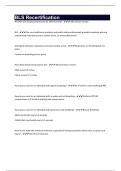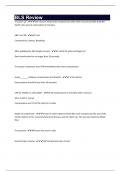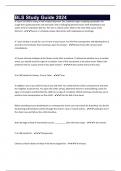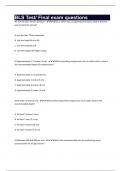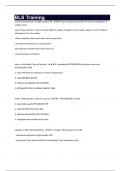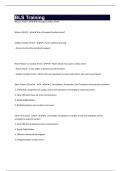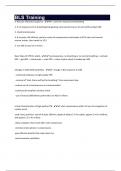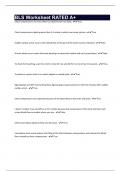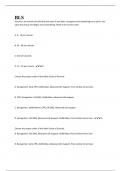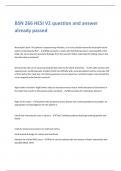AQA • BLS
Latest uploads for BLS at AQA. Looking for BLS notes at AQA? We have lots of notes, study guides and revision notes available for BLS at AQA.
-
51
- 0
-
1
Modules BLS at AQA
Notes available for the following courses of BLS at AQA
Latest content AQA • BLS
At what rate should compressions be administered? - 100-120 per minute BLS - the care healthcare providers and public safety professionals provide to patients who are experiencing respiratory arrest, cardiac arrest, or airway obstruction Distinguish between respiratory arrest and cardiac arrest - Respiratory-no breathing but has pulse Cardiac-no breathing and no pulse How deep should compressions be? - Adult-at least 2 inches Child-around 2 inches Infant-around 1.5 inches How do you car...
2 rescuer cpr - One rescuer will provide compressions while other rescuer provides breathes. Switch riles every 5 cycles (about 2 minutes) ABC's of CPR - C-A-B Compressions, Airway, Breathing After grabbing the AED (single rescuer) - -check for pulse and begin cpr (feel carotid pulse for no longer than 10 seconds) if no pulse is detected, start CPR immediately with chest compressions Avoid _______ between compressions and breaths - -Interruptions (interruptions should be less than 10 se...
A 3 year old child is eating in the hospital playroom. She suddenly begins coughing repeatedly. Her cough then quickly becomes soft and weak. She is making hig-pitched noises while breathing in and seems to be in respiratory distress. Her skin is a bluish color. What is the most likely cause of her distress? - Severe or complete airway obstruction with inadequate air exchange. A 7 year old boy is struck by a car in front of your house. You find him unresponsive and bleeding from a wound on ...
A ) Use the Jaw- thrust maneuver - When a victim has a suspected neck injury, what is the best way to open the airway? A. use the Jaw- Thrust maneuver B. Use the head tilt-chin lift C. Use the head tilt only D. Use the tongue lift-finger sweep A) Approximately 1.5 inches ( 4 cm) - When providing compressions for an infant victim, what is the recommended depth of compressions? A. Approximately 1.5 inches(4 cm) B. Approximately 1 inch (2.5 cm) C. Approximately 3 inches ( 8 cm) D. Approx...
critical characteristics of high-quality CPR - -start compressions within 10 secs of recognition of cardiac arrest -push hard, push fast. rate of at least 100/min, depth of atleast 2 in for adults, approx 2 in for children, and approx 1.5 in for infants -allow complete chest recoil after each compression -minimize interruptions in compressions -give effective breaths that make chest rise -avoid excessive ventilation Links in AHA adult Chain of Survival - 1. immediate RECOGNITION of cardi...
What is IHCA? - In-Hospital Cardiac Arrest What is OHCA? - Out-of-hospital Cardiac Arrest? Sudden Cardiac Arrest - - Occurs without warning - Occurs shortly after symptoms appear - Heart Attack vs. Cardiac Arrest - - Heart attack may cause cardiac arrest - Heart attack = a clot within a blood vessel of the heart - Sudden Cardiac Arrest = When the heart develops an abnormal rhythm and can't pump blood Adult Chain of Survival - IHCA - 1. Surveillance, Prevention, and Treatment of prearres...
2- Rescuer infant BLS sequence - 1. check for response and breathing 2. if no response and no breathing/only gasping, send second rescuer to active ERS and get AED 3. check brachial pulse 4. if no pulse, HR <60/min, perform cycles of compressions and breaths at 30:2 ratio until second rescuer arrives, then switch to 15:2 5. use AED as soon as it arrives Basic Steps of CPR for adults - 1) unresponsive, no breathing or no normal breathing -> activate ERS -> get AED -> check puls...
Chest compressions are more often too shallow than too deep. -True Chest compressions depth greater than 2.4 inches in adults may cause injuries. -True Sudden cardiac arrest occurs when blood flow to the part of the heart muscle is blocked. -False A heart attack occurs when the heart develops an abnormal rhythm and can't pump blood. -False To check for breathing, scan the victim's chest for rise and fall for no more than 10 seconds. -True To perform a pulse check in an adult, palpate a ca...
Assume a six-month-old child that has been ill and does not appear to be breathing has a pulse. You open the airway and began rescue breathing. What is the correct rate? A. 8 - 10 per minute B. 30 - 40 per minute C. Every 8 seconds D. 12 - 20 per minute - D Choose the proper order of the Adult Chain of Survival: A. Recognition, Early CPR, Defibrillate, Advanced Life Support, Post-Cardiac Arrest Care B. CPR, Recognition, Call EMS, Defibrillate, Advanced Life Support C. Recognition, Defib...
Neutrophil count- The patient is experiencing infection, so a nurse should review the neutrophil count before contacting the HCP. - While caring for a client with full thickness burns covering 40% of the body, the nurse observes purulent drainage from the wounds. Before reporting the finding, what is the best lab value to evaluate? Demonstrate the use of visual scanning during meals to the client and family. - An older woman who experienced a cerebrovascular accident (CVA) has difficulty wi...

